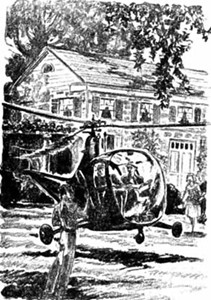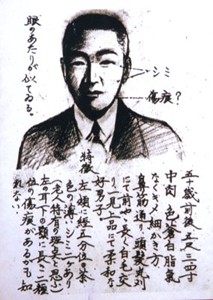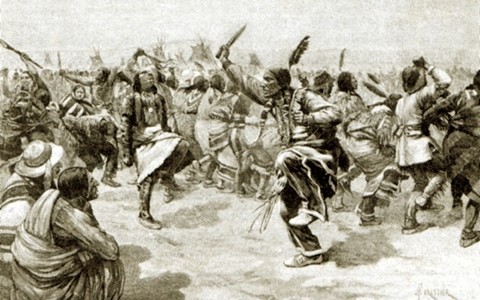Want one of your tracks to someday be posted on Microkhan? As MF Doom so amply demonstrates above, there’s one surefire way to earn that honor: mention Snake Plissken in the very first verse.
The Surest Way to Our Heart(s)
November 19th, 2009
Comments Off on The Surest Way to Our Heart(s)Tags:hip-hop·MF Doom·music·Snake Plissken
The Hilarity of Specificity
November 19th, 2009

Upon learning about the opening of the International Cryptozoology Museum in Portland, Me., we felt compelled to spend a pleasant few minutes going over the latest in Sasquatch research. What we find most entertaining about this field is not its sheer uselessness, but rather the seriousness of its tone. As demonstrated by the chart above, which purports to show the growth curve for North American Bigfoots, cryptozoologists can use visual aids as fluidly as their mainstream counterparts. And they can talk the talk, too—take, for example, this deadpan account of Sasquatchian mating habits:
Mating has been observed primarily between May and June, mostly between established pairs, and there is a suggestion of the birthing time lying between February and May. The duration of pregnancy (probably near 9 months) is partly related to the average weight of the species. Birth has been (very rarely) reported to occur in the squatting position, with other individuals nearby. The spacing of offspring is presumably governed by lowered fertility in consequence of demand feeding as well as infant mortality. On two occasions, females were observed carrying a dead infant.
As you might sense for our tone, we put the odds of Bigfoot’s existence on par with those of a Mongolian Death Worm ever being captured alive.
→ 3 CommentsTags:Bigfoot·cryptozoology·Mongolia·pseudoscience
Paint, Not Books
November 19th, 2009
There’s actually been a small silver lining to our newfound anxiety over the lead content in balsamic vinegar: it’s got us thinking about education spending in a new way. How’s that? Well, upon learning that our favorite salad-dressing base might well harm Microkhan Jr.’s neural health, we started thumbing through the literature on lead poisoning’s effects on IQ scores. Once a body starts doing that, all roads inevitably lead to this 2003 study from the New England Journal of Medicine. Its troubling conclusion is that even modest concentrations of lead in a young child’s blood can reduce IQ by an average of 7.4 points—and, presumably, far more if the poisoning is more acute.
The good news, of course, is that our nation has done an admirable job of getting rid of lead over the past several decades—not a perfect job, by any means, but there’s little doubt that lead poisoning has become increasingly rare. There’s still work to be done, and it will cost—this study (PDF) estimates that it costs an average of $7,000 to render an American dwelling unit lead-free. But the author also points out that the long-term economic returns are well worth the investment, since smarter kids wind up generating more valuable economic activity once they hit the work force.
And that got us wondering: what if the efforts of UNESCO and others to increase primary-school spending are misplaced? What if the education community’s first priority shouldn’t be getting developing nations to reach the OECD average in per-pupil outlays, but rather the de-leading of environments?
To answer the question, we need to know more about how much additional primary-school spending ends up boosting a child’s IQ—in other words, how much IQ bang we get for the each buck. This is something we’ve yet to see addressed to our satisfaction in peer-reviewed studies. (For the record, we’re well-convinced that early education makes a big difference, but that seems to be less of a priority for the likes of UNESCO.)
So, what if nations shifted a significant share of their finite education resources away from per-pupil spending in primary schools, and toward fresh coats of lead-free paint (not to mention the enforcement of tougher environmental regulations? We have no idea how such a shift would fly politically, since no one wants to be known as the leader who took money from the kids. But from a far-sighted point of view, such a maneuver might actually do wonders for a country’s long-term economic prospects.
→ 6 CommentsTags:educuation·intelligence·lead poisoning·public health·statistics·UNESCO
Hippo on the Make
November 18th, 2009
The recent dearth of posts has been due to a confluence of factors: a hectic sked of writing FOIA requests, the petty frustrations of trying to get the next Wired feature going, and the sheer agony of checking out potential preschools for Microkhan Jr. We’re almost through the worst of it, though, and we’ll be back to normal soon. In the meantime, check out the disco scene from Animalympics; we love how the hippo gets the corner tables, surrounded by what appears to be an avian harem.
The Colombian Necktie Half-Truth
November 17th, 2009

One of our favorite slept-on tracks of recent years is “Cali Hustle”, off the criminally hard-to-find Bay Bury-Ya compilation. In the song’s final verse, Mac Mall kicks off his bars with this clever line:
Colombian neckties for small fries
We’ve always taken it for granted that such a grisly fate has befallen many a criminal during the interminable War on Drugs. But a couple of days ago, we started to dig a little deeper. And, lo and behold, the Colombian necktie is not all it’s cracked up to be.
Let’s start with the part of the legend that does appear to be true: during La Violencia, a ten-year period of turmoil in the Colombian countryside, victims were frequently mutilated post-mortem. Among these atrocious techniques was the pulling of the tongue through a slit throat, a practice credibly documented by the anthropologist Maria Victoria Uribe.
But did Colombian criminals export this technique to the United States during the cocaine boom of the 1970s? And did gangsters start doing it to live victims, rather than just corpses? As much as Mac Mall might state otherwise, we can find zero evidence of this. In fact, the first mainstream American publication to use the phrase “Colombian necktie” was The Washington Post back in 1985—not in a news story, but rather in a review of the Chuck Norris vehicle Code of Silence. (The practice was referenced again in 1986’s Running Scared.)
Going forward from there, we couldn’t find a single verifiable case in the United States in which a person was killed with a Colombian necktie. The closest thing we could find was a passing mention in a 1991 Newsday article, in which a longtime prosecutor said that the Colombian necktie was a fate much worse than a mere throat slashing. But he provided no specifics, and we get the sense he may have fallen prey to the urban legend, too—a legend perpetuated by countless pulp fiction writers, who have been shouting out the Colombian necktie since at least 1981.
Of course, the Colombian necktie made an infamous cameo at O.J. Simpson’s trial, when Johnnie Cochran offered his alternate theory of the crime. But that’s hardly proof that the execution technique has ever been used on these shores.
If you or anyone you know can point us toward a verifiable instance in which a Colombian necktie was used on a live victim in the United States, we’d love to hear about it. Otherwise, we’re just going to assume that the technique belongs in the annals of urban legend, right alongside meth mouth.
Comments Off on The Colombian Necktie Half-TruthTags:cocaine·Colombia·Colombian necktie·crime·urban legends·War on Drugs
May Day in Tirana
November 16th, 2009
While watching this propaganda film of Albanian dictator Enver Hoxha celebrating May Day in 1983, we had one thought, and one thought alone: what percentage of those workers in the parade earned their living digging useless bunkers?
Comments Off on May Day in TiranaTags:1980s·Albania·Communism·Enver Hoxha
Six Months for a Jest
November 16th, 2009
The Danes are not alone in their ability to infuriate pious Muslims with drawings. A Bangladeshi cartoonist has just been sentenced to six months in prison for a work deemed blasphemous. The original kerfuffle occurred two years ago, when Arifur Rahman’s cartoon sparked riots in Dhaka. The offending artwork can be glimpsed here. The translation of the captions goes as so:
Boy, what is your name?
My name is Babu.
It is customary to add Mohammad before the name. What is your father’s name?
Mohammad Abu.
What’s this in your lap?
Mohammad cat.
The joke, as we understand it, is that Muslim people use the name “Mohammad” a lot. Not funny to our decidedly Western ears, but we’re puzzled as to how anyone’s skin could be thin enough to take offense at such a trifle. Given the violent reaction in the streets, you’d be forgiven for thinking that Rahman had blown his nose on the Koran.
Here’s to hoping that cooler heads prevail in Bangladesh, and that Rahman (whose website is here) needn’t go into exile.
Comments Off on Six Months for a JestTags:Arifur Rahman·Bangladesh·blasphemy·cartoons·Islam·religion
Transformation or Calculation?
November 16th, 2009

One of our favorite scenes in The Godfather trilogy occurs near the beginning of the second installment, as Michael Corleone dances with his wife at a lavish party in honor of their son’s First Communion. Kay Corleone asks her hubby when, exactly, the family will go legit—something that Michael promised several years prior. “I’m trying, darling,” comes the reply, and the viewer isn’t sure what to think—is Michael being honest with his missus, or does he have no intentions of ever going completely straight?
A similar scenario is now playing out in Kenya, where a don of the Nairobi underworld has publicly turned his back on his former life in favor of the Church, the kids, and (perhaps) mainstream politics. Maina Njenga was one of the founders of the Mungiki, sort of the Kikuyu version of the Latin Kings—part self-help fraternal order, part violent street gang. (Okay, mostly the latter.) But after serving five years in prison, Njenga recently announced that he’s seen the light and accepted Jesus Christ as his savior. That conversion has made him a marked man in the underworld, since the Mungiki is tied together by a quasi-animist religion that views Christianity with great suspicion. (Njenga used to encourage his gangster followers to pray to Mount Kenya, for example.)
Yet is Njenga’s conversion sincere, or part of a master plan to compete for elected office in 2012? Check out this recent radio interview and decide for yourself:
Q. You’ve talked of bringing your members together for income generating activities, what is your source of revenue in this new venture?
A. I am going to work with church people and civil society organisations. I am also going to work with the government people. We are even planning to look for NGO’s to support us. I am even planning to start creating cities so that the youth can get jobs.
Q. Tell us more about these cities.
A. One way of creating jobs to these young men is to build cities. I want to build seven wonderful cities. I am starting with putting up a hotel here in Kitengela and later in other areas. You know if I put up a hotel. Someone else will come and put a shop, another person will put other facilities.
Q. You have also formed a political party, the Kenya National Youth Alliance, what do you aim to achieve? Does it have anything to do with the 2012 General Elections and your political ambitions?
A. Let us not talk about that at this point.
You can learn more about the Mungiki’s religious practices by watching this documentary; it includes an interview with Njenga during one of his less harmonious phases.
Comments Off on Transformation or Calculation?Tags:crime·Kenya·Maina Njenga·Mungiki·politics·The Godfather
You Can’t Stop the Horse
November 16th, 2009
Late start today, due to the fact we stayed up late last night watching our beloved Colts mount a miraculous comeback against their archenemies. For the record, we think Belichick’s gamble was a good one—the Pats had been unstoppable in short-yardage situations all night, and the Colts’ D has been decimated by injuries. That said, we’re glad the pigskin gods saw fit to spread joy in Indy.
Still Waiting for Our Mini-Chopper
November 13th, 2009
 It just seemed cruel to cap the week with Ms. O’Donnell’s execrable work, so we’re gonna give you a retro-futuristic treat: a World War II-era view of the rise of personal aircraft. The pamphlet’s title really says it all: Will There Be a Plane in Every Garage? The answer, as you might surmise, is a qualified “yes,” though the authors did foresee the mini-helicopter someday becoming Joe America’s backup means of vehicular transport:
It just seemed cruel to cap the week with Ms. O’Donnell’s execrable work, so we’re gonna give you a retro-futuristic treat: a World War II-era view of the rise of personal aircraft. The pamphlet’s title really says it all: Will There Be a Plane in Every Garage? The answer, as you might surmise, is a qualified “yes,” though the authors did foresee the mini-helicopter someday becoming Joe America’s backup means of vehicular transport:
The helicopter will do many things that it is impossible for a car to do, and it will do many things that the car can do, only much better. It can land almost anywhere, even on swampy marsh land or on water (with rubber bag floats). Where it can’t land, as in thick forests or on rough, rocky terrain, it can hover in mid-air a few feet over the spot and lower a rope ladder by means of which you can reach the ground.
On the other hand, it would not be practical for you to jump into a helicopter and flit down to a newsstand a few blocks away to pick up a Sunday paper. You’d be better off using an automobile on such a trip through city streets. The auto and the helicopter supplement each other very well. You can use your car in crowded congested urban areas and your helicopter for all other travel.
We are appalled by the fact that this has not yet come to pass. If only we could enter some sort of suspended animation until such a reality came to be—or at least until our savings account accrued enough interest so that we could buy a car.
Also of interest in this series of wartime pamphlets: What Has Alaska to Offer Postwar Pioneers? (Aside from the stated 146-100 male-to-female ratio, that is.)
“Thrillingly Embarrassing”
November 13th, 2009
After a week’s hiatus, Bad Movie Friday returns with a vengeance, in the form of the made-for-TV Rosie O’Donnell vehicle Riding the Bus with My Sister. Perhaps Ms. O’Donnell reckoned that her star turn as a mentally handicapped woman would be critic proof, as no one wants to be accused of insensitivity. But she didn’t account for the sly critical genius of Virginia Heffernan, who set upon this stinker like a 13th-century Mongol horde upon a defenseless city on the steppe:
This underhanded movie makes Ms. O’Donnell into an appalling cartoon only to pretend innocence – or, no, moral superiority – when the viewer is appalled. Is Beth’s voice deafening on your television set? Is her lumpy form in a Tweety Bird T-shirt depressing? Is her nascent sexuality hard to contemplate? You must have no heart. And you will have to come around to her innocent wonders…
The viewer, meanwhile, is sure to cringe – and often. This is another inexplicable effort by an actor to overplay a slow, strange character and teach everybody lessons. The sanctimonious old stunt is not fair to viewers. This is a deeply – even thrillingly – embarrassing movie.
We’re curious to know how many of y’all can watch the entire clip above. We made it to the 1:36 mark, then had to look away in horror.
→ 5 CommentsTags:Bad Movie Friday·movies·New York Times·Riding the Bus with My Sister·Rosie O'Donnell
A Life Spent in Limbo
November 13th, 2009
 Since 1983, the average amount of time a condemned American convict spends on death row has tripled to 153 months. Yet that mammoth stretch of time is nothing compared to that endured by Sadamichi Hirasawa. When he passed away from natural causes in 1987, the alleged mastermind of Japan’s most infamous and lethal bank robbery had racked up 37 years waiting for the noose.
Since 1983, the average amount of time a condemned American convict spends on death row has tripled to 153 months. Yet that mammoth stretch of time is nothing compared to that endured by Sadamichi Hirasawa. When he passed away from natural causes in 1987, the alleged mastermind of Japan’s most infamous and lethal bank robbery had racked up 37 years waiting for the noose.
The eternal delay had much to do with the circumstances surrounding Hirasawa’s conviction. The facts of the crime were never in doubt: in 1948, a man conned a dozen bank employees into drinking cyanide, under the pretense that he was administering them a liquid vaccination for dysentery. But since the start, there have been credible rumors that Hirasawa was just a scapegoat, and that the real culprit was someone with close ties to Unit 731, the clandestine group that carried out horrific biowarfare experiments during World War II. This alternative theory goes something like this:
As the investigation progressed, the evidence began to implicate a former member of Unit 731 of the Imperial Army—the unit which, under the command of Lt. Gen. Shiro Ishii, conducted biological warfare research in Manchuria by means of grisly experimentation on captured prisoners. The poison in teh bank robbery was administered, it was learned, by a method used regularly in Manchuria. One survivor was certain the murderer was a doctor. General Ishii himself was called in to “consult” on the case.
Suddenly, however, this line of investigation was terminated, apparently at the behest of someone high in MacArthur’s command. With the Japanese public clamoring for action, the police turned their attention again to Hirasawa, who was convicted and sentenced to death.
MacArthur supposedly had a keen interest in granting amnesty to Unit 731’s members, so that their expertise could be tapped in the service of America’s burgeoning bioweapons program. To this day, that is a narrative that Hirasawa’s descendants continue to try and bring to light.
Plenty of primary-source documents can be found here, though many require a working knowledge of Japanese to decipher fully. And one of Hirasawa’s self-portraits from death row can be glimpsed here.
→ 2 CommentsTags:art·death penalty·Japan·Sadamichi Hirasawa·Teigin Case·Unit 731
“I Spray Like the Backside of a Skunk”
November 12th, 2009
The rest of our day looks certain to be divvied up between childcare and working on a major secret project, so let us leave you with the latest from Big Boi—yet another track we got turned on to by the Fresh Produce crew. We can barely understand a word that guest star Gucci Mane slurs out, but it still sounds grand to our khanic ears.
Comments Off on “I Spray Like the Backside of a Skunk”Tags:Big Boi·hip-hop·music
The Criteria of Clowndom
November 12th, 2009
In response to our tongue-in-cheek allusion to the Shriners in this post, a treasured reader noted that his uncle was a “Shriner clown.” At first we took this to be some sort of jest, but The Tubes quickly proved us wrong: the fez-wearing brotherhood is darn serious about its clowning. In fact, the organization hosts frequent contests in which clowns vie for a range of coveted titles. The point of these events is to exude clown perfection, as outlined by the International Shrine Clown Association. Our favorite snippet from the rules is this definition of the paragon of the “Happy Hobo” clown type:
The HOBO wants to be a HOBO; he may be down but he certainly is not out. He often appears to be HAPPY. A HOBO usually will not ask for a ‘handout’, preferring to work for it. He will take a job-but usually not for long because he wants to move along to someplace else. His face is much like the tramp’s make-up except in the expression. He is apt to smile, and his eyes generally appear larger, more wide awake, open, and HAPPY looking than the tramp’s eyes. His costume is quite similar to the tramp’s, but may contain brighter colors in various parts. His vest is likely to be a bright color, as are many of his patches. His shoes should be the same as the tramp’s. The TRAMP/HOBO category is the only category in which the use of any kind of color gloves, gloves with holes, gloves with fingers cut off,or the complete absence of gloves is permitted. However, if gloves are used, they should be CLEAN but APPEAR DIRTY, STAINED, and WORN. The overall effect of make-up, costuming, and performance must compliment the character portrayed.
For the record, the reigning Happy Hobo champion of Texas appears to be one Jerry “Peeps” Pherson. Congrats to him, though we do wonder if he’s familiar with the hardships faced by Depression Era hobos. Not too many happy campers in that lot.
Bulletproof: The Mai Mai
November 12th, 2009
![]() Our second installment of the Bulletproof Project takes us to the eastern Congo, where Mai Mai militiamen have been wreaking awful havoc for years now. These soldiers are known not only for their brutality, but also their unwavering faith in dawa, or sinister magic. This belief became apparent to Western observers during the violent upheaval that followed Congo’s independence, when various ethnic groups fought the idea of a centralized nation-state. The Kinshasa regime had the latest in Belgian military hardware at its disposal, which led the rebels deep into dawa:
Our second installment of the Bulletproof Project takes us to the eastern Congo, where Mai Mai militiamen have been wreaking awful havoc for years now. These soldiers are known not only for their brutality, but also their unwavering faith in dawa, or sinister magic. This belief became apparent to Western observers during the violent upheaval that followed Congo’s independence, when various ethnic groups fought the idea of a centralized nation-state. The Kinshasa regime had the latest in Belgian military hardware at its disposal, which led the rebels deep into dawa:
Faced with superior military technology, they tended to rely on supernatural resources. How else could men and women with no more than bows and arrows overcome guns and bullets, except with the help of a pantheon of spirits that would transform lethal bullets into harmless raindrops? Just as in the Mayi Mayi resistance in pre-World War I Tanganyika and many a rebellion thereafter, so in the Mulelist uprising in Congo of the 1960s magic turned out to be a key component of rebellion. Rebel forces marching into battle chanted “Mulele Mai! Mulele Mai!” evoking the power of Mulele the leader to turn bullets into Mai, literally, water.
This technique, sometimes abetted by charms or body paint, did little to protect the fighters. It did, however, horrify one of their most celebrated allies: Che Guevara, who was gobsmacked by the rebels’ faith. To his consternation, he discovered that his revolutionary brothers felt no need to train or plan, since they assumed that they would triumph in any battle thanks to dawa. The Mai Mai did, however, spend plenty of time getting sauced before battle, which may account for their ferocious reputation.
More on the Mai Mai’s religious beliefs here, and a great photo set about the ongoing Congolese security disaster here.
Comments Off on Bulletproof: The Mai MaiTags:Africa·Che Guevara·Congo·insurgencies·Mai Mai·The Bulletproof Project
Gone Too Soon
November 11th, 2009
We first got turned on to Donny Hathaway by reading the liner notes for The Chronic. We were amazed by how many of the samples were copped from Extension of a Man, and so we saved up some hard-earned cash to buy the album. It’s since become one of our favorites, a platter we’ve spun on countless occasions when we require sonic escape.
There’s no telling where Hathaway’s career might have taken him if he’d been born, say, a decade later. But during his early ’70s heyday, medical science just didn’t have the means to deal with his paranoid schizophrenia—the disease that ultimately led him to take his own life in spectacular fashion.
There’s a poignant essay about Hathaway’s descent into mental illness here. And his daughter has blossomed into a great singer, too.
→ 2 CommentsTags:Donny Hathaway·music·R&B·schizophrenia·suicide
“Beam the Bomb”
November 11th, 2009

After posting a vintage pro-SDI ad on Monday, we got to wondering about this “Coalition for SDI” that sponsored the spot. Who could be so bold as to create the risible “Peace Shield” euphemism?
We connected the dots back to Daniel O. Graham, who claimed to be the coiner of the term “Strategic Defense Initiative.” The Coalition for SDI was just one of the Astroturf groups he organized with the assistance of the American Security Council. The whole tale of Beltway intrigue is spun splendidly in the eleventh chapter of Reaching for the High Frontier, a history of America’s pro-space lobby from the Nixon to Reagan administrations. Our favorite snippet regards some of the unintended allies that Graham picked up along the way:
In May 1983, Congressman Ken Kramer of Colorado introduced a “People Protection Act,” which called for the creation of a directed energy systems agency, a military Space Shuttle fleet, a unified Space Command, a manned space station program, and consideration of new arms control regimes using strategic defenses. Armstrong introduced a parallel measure in the Senate. Newt Gingrich also was supportive, including the idea of space-based ABM in his 1984 book Window of Opportunity.
The Strategic Defense Initiative also drew strong support from the Fusion Energy Foundation and from the publication Executive Intelligence Review, both of which are associated with the Presidential candidacy of Lyndon LaRouche. These organizations, which had begun campaigning for a space-based missile defense system in May 1982 (possibly in response to the High Frontier report), emphasized the economic as well as the military benefits of the beamed-energy research that would be conducted. One of their slogans was “Beam the Bomb.”
Oddly, the lobbyist who fronted the Coalition for SDI on Graham’s behalf, an Alabaman named Rick Sellers, has since moved on to very different right-wing terrain.
→ 3 CommentsTags:1980s·Daniel O. Graham·Lyndon LaRouche·politics·space·Strategic Defense Initiative
The Sad Ballad of Snake Bite Jones
November 11th, 2009

The man to the right of the pelican above is Bryan Vorster, a South African animal handler who loves to edutain the kids. Under the nom de scène Snake Bite Jones, he’s long been a fixture at the Johannesburg Zoo, where he thrills audiences by trotting out a vast array beasts—including the vultures used in such cinematic gems as Lord of War and Blood Diamond. “We need to teach children to love animals,” he insists, which perhaps explains why he continues to soldier on despite having been bitten by venomous reptiles upwards of 50 times.
But has Vorster’s life’s work now tilted into dangerous obsession? Because it’s not every animal handler who gets caught sneaking new performers across the Namibian border:
Vorster is accused of illegally importing five spitting cobras, two pythons, three chameleons, three geckos and a centipede.
He was arrested at the Vioolsdrift border in the Northern Cape last week…Last week, officials from the Northern Cape Department of Environment and Nature Conservation’s inspection services unit followed a tip-off and found the wildlife allegedly hidden in Vorster’s vehicle, while he was trying to cross the border from Namibia.
Thabo Ditseho, spokesperson for the ministry of environment and nature conservation, said Vorster was well known in reptile circles and was “fully aware of the requirements that permits are needed to import reptiles…The illegal collection of reptiles and other wildlife is a serious problem in the Northern Cape, and there is an increase of this activity during the hotter months of the year,” he said.
The detail that surprised us the most? The fact that Vorster is on the hook for smuggling a centipede. We wouldn’t think such creatures would be part of a wildlife control regime. We certainly have no trouble finding them in our shower drain whenever we travel in less smoothed-out corners of the globe.
Also, to our puzzlement, Bryan Vorster seems to be no relation to fellow South African Corne Vorster, who recently spent 10 hours caged up with 40 deadly snakes. She did so in the company of one of Snake Bite Jones’ apparent rivals for reptile supremacy, Nutty Natie Swart.
→ 1 CommentTags:crime·reptiles·smuggling·Snake Bite Jones·snakes·South Africa·wildlife management
The Mother of All Marvin Covers
November 10th, 2009
Our pal who lusts after a Mozambique holiday also co-hosts one of the best Internet radio shows you’ve never heard of: Fresh Produce, which broadcasts far too seldomly from “an undisclosed location in South London.” The show’s most recent installment kicks off with the Hot 8 Brass Band doing a bonkers cover of “Sexual Healing,” featuring one of the most memorable breaks in musical history. See above for a live version, recorded in Paris last year. Highly, highly recommended.
→ 3 CommentsTags:Fresh Produce·Hot 8 Brass Band·Marvin Gaye·music
The Vaccine Dream Deferred
November 10th, 2009
An MIT economist argues that botched incentives, rather than scientific hurdles, are frustrating the quest for an HIV vaccine. The point that jumped out at us the most:
It has become increasingly apparent that an HIV vaccine may need to be administered in combination with antiretroviral drugs, even if a stand-alone vaccine remains the ultimate goal for some researchers. In that case, we will need to create stronger incentives for manufacturers of antiretroviral drugs to get into the business of prevention. Right now, antiretroviral producers see HIV-infected people as their best customers.
A brutal judgment, perhaps, but certainly correct. Drug makers could do a lot to further the vaccine cause, especially since they harbor so much proprietary data created by their trials. But they have little incentive to share, since the development of a vaccine could eventually dinosaur their (for lack of a better term) “maintenance” business.
So how do we get these pharmaceutical rivals on the same page, without resorting to some sort of central planning method? And should government be the mediator that brings the two sides together?
The abstract of the full Health Affairs piece on the topic is here, but the PDF is behind a paywall. If anyone has access and can shed more light on the author’s proposed solution to creating an alliance between drug and vaccine makers, we’re all ears.
→ 3 CommentsTags:disease·economics·HIV·medical science·public health
Stars and Stripes Pale in Comparison
November 10th, 2009

A pal of ours recently quipped that he’s always had a yen to visit Mozambique, albeit because he’s always dreamed of traversing the sandy beaches of the Bazaruto Archipelago. No, our friend is attracted to the nation for a single, simple reason: he digs flags that feature weapons, and Mozambique’s official banner certainly qualifies.
Given his proclivity for flags that nod toward bellicose intentions, where else should our great pal add to his dream itinerary? There are far more choices than we ever dreamed, but none boasts a flag quite as sublimely badass as Yaroslavl Oblast. The angry bear would be reason enough to applaud the patriotic design, but the heavy battle axe really functions as a perfect cherry to the vexillological sundae.
We’re by no means the first folks to take note of the Russian region’s supremely awesome flag. But how did the good folks of this oblast luck into such a great symbol? The backstory only adds to the allure:
Yaroslavl was established in 1010 A.D. by Yaroslav the Wise of Novgorod and Kiev fame. Legend has it that he and his companions came across this area, where a village of some pagan, bear-worshipping people was located. He felt that this spot would be a good one on which to build a citadel and suggested that the locals become Christians and his subjects. They refused. So he made a deal with them: he would fight/wrestle a bear of their choice. If the bear killed him, that would be the end of the story. If he killed the bear, then the pagans would accept the Christian God and join his domain. Well, Yaroslav managed to kill the bear with his battle axe, and his opponents then became his subjects. His built a kremlin overlooking the Volga River, which the Bolsheviks later tore down. But the city’s coat of arms remains a bear carrying an ancient battle axe.
Another version of the tale claims that Yaroslav didn’t best a mere champion bear, but rather a bear demi-god worshipped by the locals. Not sure we buy that, though.
→ 3 CommentsTags:animals·bears·flags·Medieval history·Russia·Yaroslav the Wise·Yaroslavl Oblast
The Peace Shield
November 9th, 2009
In response to Friday’s post on the launch of our “Bulletproof Project,” a commenter wryly noted that we should include the Strategic Defense Initiative among our list of magical shields. That quip naturally reminded us of this classic ad, in which a pro-SDI group tried to break down the appeal of Star Wars into the most elementary pitch imaginable. See, the crayons stop the ICBMs. Obviously.
→ 1 CommentTags:1980s·advertising·Strategic Defense Initiative·TV
Mark of the Least
November 9th, 2009
Want to ruin your chances of attending a Chinese university? Simply get tattooed:
At the National Entrance College Examination of 2009, Zhong was accepted into a major university in Chongqing. But after the physical examination, the university ultimately refused to accept him because of the wolf head on his chest. Zhong’s university dream was broken.
This strikes us as a terribly harsh penalty, especially considering that the supposed “crime” is one that Microkhan and millions of others have joyously committed. But the Chinese revulsion to Western-style tattoos likely stems from an age-old association between body art, “barbarism, and criminality” (PDF).
But if the mandarins of that Chongqing university were to look back through the ancient literature, they’d find that high-ranking members of Chinese society weren’t always so bent on preserving plain appearance:
Occasionally the records reveal a relatively open-minded soul, one willing to accept customs of other peoples as aberrant but not necessarily abhorrent. There is a passage in the Zhanguo ce (Intrigues of the Warring States) in which the king argues that his people should not, out of principle, follow one superior custom, but that clothing and customs may be adopted according to the occasion. He mentions that the Ouyue people are characterized by disheveled hair, tattooed bodies, engraved arrns and with only the left shoulder covered; these things, he claims, appear strange merely because we are ignorant of them. Chinese should familiarize themselves with these customs and, if necessary, adopt them. The issue of whether one’s behavior is honorable or practical is more important than the consistent maintenance of one’s own familiar customs.
The whole paper on the history of Chinese tattooing is worth a read; we especially liked the passage about the “barbarians” who were hired to catch sea monsters, using their tattoos as camouflage.
Livin’ It Up in Kiev
November 9th, 2009

At first glance, there doesn’t seem to be much of interest in this plain-Jane rundown of Ukrainian President Viktor Yuschenko’s income and assets. The man who rose to the top of Ukraine’s political structure after surviving a bizarre assassination attempt is certainly well-off by his nation’s standards, but it’s not like he’s pulling a pulling a Bongo on his people.
But upon closer inspection of Yuschenko’s loot, we did a double-take at his choice in personal motor vehicles: when not sitting in the rear of a state-owned limo, the man apparently likes to tool around in a beloved ZAZ-965, the poster-child for the shortcomings of Leninist engineering. We can only surmise that Yuschenko’s vehicular choice is all about keeping it real, Slavic-style, because the flagship model of the Zaporozhets brand was somewhat less than well-built:
In the wake of Russia’s early Space Race victories and in an effort to create a vehicle that would rival the VW Beetle, Krushchev ordered the construction of an affordable “people’s car.” Production began in 1958 at the Zaporozhets Automotive Factory (ZAZ) in Ukraine. The general secretary, who had just been humiliated in France when presented with a coupe too small to contain him, approved the small but sturdy Zaporozhets only after ascertaining that it could fit his large frame, albeit snugly. It sold well. Factory legend held that the head engineer, Vladimir Steshenko, based his pricing formula on the idea that the car should never cost more than 1,000 bottles of vodka…
But much like the leader who gave it his blessing, the Zaporozhets proved too temperamental to trust. It broke down frequently. The engine emitted a steady, hell-raising roar and had trouble with speeds over 80 miles per hour. Worst of all was the bonnet-loaded fuel tank that tended to explode in front-end collisions. People began to joke that the car never passed any of its safety tests because the test dummies ran away, terrified. But its ungainly shape and appearance were what truly made the Zaporozhets a national punchline. Shortened to “zapor,” the name translated to “constipated.”
Check out a vintage Zaporozhets in action here or here. And Mr. Yuschenko, if you’re reading this—while Microkhan certainly doesn’t endorse any matter of kleptocracy, we do think you should use the people’s money to buy yourself a slightly better vehicle. May we suggest something from Crazy Vaclav’s?
Comments Off on Livin’ It Up in KievTags:cars·Soviet Union·Ukraine·Viktor Yuschenko·Zaporozhets
“Kingdom of Heaven Number One”
November 6th, 2009
No Bad Movie Friday this week, as The Tubes yielded up precious few usable clips from Smokey and the Bandit Part 3. Instead, we’re gonna hit you with a special treat—rare archival footage from the heyday of Father Divine, taken during his prosperous Harlem phase. It’s best viewed in tandem with this 1953 Life spread, which neatly sums up Father Divine’s penchant for ostentation:
In the peaceful setting of Pennsylvania’s wealthy Montgomery County, 20 miles into the Schuykill River countryside near Philadelphia, two universes and their undisputed rulers collided quietly last week. The occasion was the dedication by Father Divine of a 73-acre estate and its 32-room Gothic chateau as the newest of some 75 “heavens” and “the country seat of the world.” For the event, Father Divine, whose followers regard him as God, Dean of the Universe and Harnesser of Atomic Energy, had invited Prophet Jones, head of Universal Church of Triumph, Dominion of God, Inc., to be in attendance…When the train pulled in, Father Divine was there, accompanied by 15 limousines.
Apparently the man born George Baker Jr. really knew how to host a banquet, too.
Comments Off on “Kingdom of Heaven Number One”Tags:Bad Movie Friday·Father Divine·Harlem·nuclear power·religion
The Bulletproof Project
November 6th, 2009

If you’ve yet to read this jarring New York Times piece, do yourself a big favor and click over stat. It’s a damning account of how the Iraqi cops have been duped into buying a handheld “bomb detector” that apparently works no better than an old-school divining rod. Scary stuff, considering that so much of the country’s security depends on the effectiveness of checkpoints.
The article got us thinking about how folks come to believe in snake-oil solutions, even when the consequences of that belief can be fatal. And that line of inquiry has led us to launch yet another semi-regular Microkhan feature: The Bulletproof Project, in which we will document the various instances throughout history in which people foolishly believed that a certain charm, garment, or spell made their bodies impervious to ordnance.
We’re kicking off the series with the case of the ghost shirts, sacred garments worn by the Lakota Sioux during the Wounded Knee Massacre. The shirts were an integral part of the Ghost Dance religion (depicted above), a sort of 19th-century ethnic pride movement crossed with traditional Native American mysticism. In the fervor to resist American expansionism, Lakota Sioux shamans created a dangerous delusion at the worst possible time:
After issuing hardtack for breakfast rations, Colonel Forsyth informed the Indians that they were now to be disarmed. “They called for guns and arms,” White Lance said,” so all of us gave the guns and they were stacked up in the center.” The soldier chiefs were not satisfied with the number of weapons surrendered, and so they sent details of troopers to search the tepees. “They would go right into the tents and come out with bundles and tear them open,” Dog Chief said. “They brought our axes, knives, and tent stakes and piled them near the guns.”
Still not satisfied, the soldier chiefs ordered the warriors to remove their blankets and submit to searches for weapons. The Indians’ faces showed their anger, but only the medicine man, Yellow Bird, made any overt protest. He danced a few Ghost Dance steps, and chanted one of the holy songs, assuring the warriors that the soldiers’ bullets could not penetrate their sacred garments. “The bullets will not go toward you,” he chanted in Sioux. “The prairie is large and the bullets will not go toward you.”
We wonder how this madness could have come about, given that the Lakota Sioux were perfectly familiar with firearms. How could they possible overlook the total absence of first-hand evidence attesting to the shirts’ uselessness? It never ceases to amaze us how people will see only what they want to see, if their circumstances are desperate enough.
We already have a few more Bulletproof Project entries in mind, but we could use some suggestions, too—contemporary as well as historical, please. We know these kinds of lethal delusions persist, despite the supposed triumph of the scientific method.
→ 13 CommentsTags:Ghost Dance·Iraq·Native Americans·New York Times·The Bulletproof Project·U.S. history·Wounded Knee Massacre
If the Cosmos Turn Against Us
November 5th, 2009
 Of all the sundry worries that vex us every day, annihilation by celestial object is fairly low on the list. The same can’t be said of the insurance industry, which knows it could be wiped out if we ever got another Tunguska event of 1908. If something similarly destructive happened in the skies above New York, what sort of price tag could we be looking at? Risk Management Solutions Inc. is glad you asked:
Of all the sundry worries that vex us every day, annihilation by celestial object is fairly low on the list. The same can’t be said of the insurance industry, which knows it could be wiped out if we ever got another Tunguska event of 1908. If something similarly destructive happened in the skies above New York, what sort of price tag could we be looking at? Risk Management Solutions Inc. is glad you asked:
Their report, “Comet and Asteroid Risk: An Analysis of the 1908 Tunguska Event,” predicts if a medium-sized comet exploded over the borough of Manhattan, the damages would be massive. With the damage footprint encompassing the outer boroughs and Northern New Jersey, total losses may well top $1 trillion.
“Total economic exposure measures $760 billion between the outer and inner contours of the footprint, and $1.38 trillion inside the inner contour,” the report states. “As a result, property losses are estimated at approximately $1.19 trillion.”
Fortunately, the study notes earth-impacting objects of appreciable size are exceedingly rare, estimating a mean return period of 1,000 years (range from 400 to 1,800 years) for collisions with objects similar in size to the 1908 Tunguska event. What’s more, with oceans covering 70% of the earth’s surface, the odds of a direct strike on a metropolitan area are further reduced. Yet, no matter how remote the possibility of such an event insurers need to take precautions.
Those precautions basically boil down to spreading the risk, by making sure no single metropolis carries too many policies. But a question: wouldn’t an asteroid strike qualify as a proverbial “act of God,” and thus not be covered by basic homeowner’s insurance? Are the likes of RMS proposing a surcharge for Tunguska insurance? And if so, which ultimately has better odds of paying out—asteroid coverage, or a Powerball ticket? We’re actually leaning toward the latter, at least if you factor in the cost—we presume Tunguska insurance will run more than $1 per lifetime.
→ 4 CommentsTags:asteroids·insurance·statistics·Tunguska event
Really? These Guys?
November 5th, 2009

Before the Sandman took hold last night, we managed to dive into the first few pages of Lawrence Wright’s New Yorker piece on last January’s war in Gaza. It’s a topic we know little about, and so we were genuinely surprised by a passing mention regarding the paranoia of Hamas. According to Wright, the organization’s stated enemies include none other than the Lions Club, which Hamas considers a major backer of Zionism.
This struck as an exaggeration—how could anyone feel threatened by a bunch of do-gooding old-timers in yellow vests? But sure enough, Article Twenty-Two of the Hamas Convention lays it all out:
For a long time, the enemies have been planning, skillfully and with precision, for the achievement of what they have attained. They took into consideration the causes affecting the current of events. They strived to amass great and substantive material wealth which they devoted to the realisation of their dream. With their money, they took control of the world media, news agencies, the press, publishing houses, broadcasting stations, and others. With their money they stirred revolutions in various parts of the world with the purpose of achieving their interests and reaping the fruit therein. They were behind the French Revolution, the Communist revolution and most of the revolutions we heard and hear about, here and there. With their money they formed secret societies, such as Freemasons, Rotary Clubs, the Lions and others in different parts of the world for the purpose of sabotaging societies and achieving Zionist interests. With their money they were able to control imperialistic countries and instigate them to colonize many countries in order to enable them to exploit their resources and spread corruption there.
According to the Sydney Morning Herald, Hamas’s anti-Lions sentiment can be traced back to a noted Holocaust denier, who is apparently as daft as The Simpsons Mr. Burns during his Howard Hughes phase.
While we have little doubt the Lions are a pro-Western group, we really can’t see them having the evil streak required to plot the destruction of Islam. No, only the Shriners are capable of such menace.
→ 8 CommentsTags:conspiracy theories·Freemasons·Gaza·Hamas·Israel·Lions Club·Middle East·Shriners
“Be Cool, or Be Cooled”
November 4th, 2009
Earlier this year, we rescued several heaping armfuls of vinyl from a building on our blocks that’s undergoing a gut renovation. Many of the platters were too damaged to be of use, but there were gems amidst the trash—most notably an original pressing of the soundtrack for Three Tough Guys (aka Tough Guys). The lead cut off the B side, “Hung Up on My Baby, provided the hook for the Geto Boys most memorable tune. As for the movie itself—well, we’ve yet to see the whole thing, but anything in which Isaac Hayes plays one half of a vigilante priest/ex-cop tandem can’t be bad, right?
→ 2 CommentsTags:Geto Boys·hip-hop·Isaac Hayes·movies·music·Three Tough Guys
The Marching Powder
November 4th, 2009
 When Latin percussion god Tito Puente died some years back, The New York Post speculated that a 40-year cocaine addiction had finally caught up with the man. This piece of gossip turned out to be of (to say the least) dubious veracity, but it stuck with us nonetheless. That’s because it got us thinking about whether or not cocaine use inevitably leads to addiction, one of the central tenets of the “Just Say No” campaign that was inescapable during our Reagan Era youth.
When Latin percussion god Tito Puente died some years back, The New York Post speculated that a 40-year cocaine addiction had finally caught up with the man. This piece of gossip turned out to be of (to say the least) dubious veracity, but it stuck with us nonetheless. That’s because it got us thinking about whether or not cocaine use inevitably leads to addiction, one of the central tenets of the “Just Say No” campaign that was inescapable during our Reagan Era youth.
The issue is more salient than ever, now that skepticism about the War on Drugs appears to be reaching critical mass. With marijuana seemingly headed for decriminalized status in at least a handful of states, will there eventually be an organized movement calling for a similar rethink on cocaine?
We’re not yet convinced that the emergence of a National Organization for the Reform of Cocaine Laws (NORCL) would be a good thing, but we are curious about the evidence attesting to the true nature of coke’s addictive powers. The typical Drug Warrior stat is that three-quarters of those who try the drug will become addicts. But as with so many figures spouted by those with a vested interest in maintaining blanket prohibition, this number is never accompanied by credible sourcing. Much more believable, then, is the state cited in this New York Times piece:
According to the Institute of Medicine of the National Academy of Science, 32 percent of people who try tobacco become dependent, as do 23 percent of those who try heroin, 17 percent who try cocaine, 15 percent who try alcohol and 9 percent who try marijuana.
Those stats alone aren’t enough to sway us into the NORCL camp. But another data point worth considering are the conclusions found in the World Health Organization’s 1995 report on cocaine use (PDF). The report, allegedly suppressed by the U.S., clearly doesn’t regard occasional cocaine use as any more deleterious to personal and public health than good ol’ drinking:
In all participating countries, health problems from the use of legal substances, particularly alcohol and tobacco, are greater than health problems from cocaine use. Also, in many countries, chronic problems related to poverty, hunger, infectious diseases, war and social disorder overshadow any health problems related to cocaine use. Most participating countries agree that occasional or experimental cocaine use does not typically lead to severe or even minor physical or social problems.
Yes, we’re well-aware of the downside of what the WHO describes as “intensive use”—in fact, we lost a cherished family member to the habit. But we’ll confess to having an Economist-style libertarian streak, as well as a love for scientific reason. If cocaine is, indeed, far less addictive than commonly advertised, shouldn’t we at least start having the conversation as to how it might be effectively brought aboveboard and regulated?
→ 12 CommentsTags:cocaine·drugs·public health·Tito Puente·War on Drugs·World Health Organization


